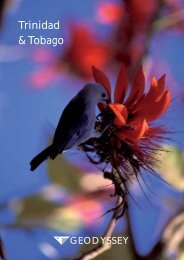Ecuador and the Galapagos Islands - Geodyssey
Ecuador and the Galapagos Islands - Geodyssey
Ecuador and the Galapagos Islands - Geodyssey
You also want an ePaper? Increase the reach of your titles
YUMPU automatically turns print PDFs into web optimized ePapers that Google loves.
The Galápagos Isl<strong>and</strong>s ê GUIDE<br />
The isl<strong>and</strong>s<br />
All <strong>the</strong> isl<strong>and</strong>s in <strong>the</strong> Galápagos are<br />
volcanic, some actively so, <strong>and</strong> <strong>the</strong>ir<br />
scenery is correspondingly varied <strong>and</strong><br />
often dramatic. Each has its own ecologies<br />
supporting different species: a Galápagos<br />
guidebook is essential to cover <strong>the</strong> details of<br />
so much diversity.<br />
Flights from <strong>the</strong> mainl<strong>and</strong> arrive at airstrips<br />
at ei<strong>the</strong>r Baltra or San Cristóbal. All cruises<br />
start at <strong>the</strong>se entry points or at Puerto Ayora,<br />
reached by road from Baltra.<br />
Santa Cruz<br />
Santa Cruz is <strong>the</strong> hub of <strong>the</strong> Galápagos, with<br />
<strong>the</strong> largest town, Puerto Ayora, on its south<br />
coast.<br />
Travelling from <strong>the</strong> airstrip at Baltra Isl<strong>and</strong><br />
to join a yacht moored at Puerto Ayora you<br />
travel across <strong>the</strong> scrubby interior, passing<br />
between The Twins–two large sink holes.<br />
The Charles Darwin Research Station <strong>and</strong><br />
its tortoise conservation <strong>and</strong> breeding centre<br />
are just outside Puerto Ayora.<br />
At Black Turtle Cove, small boats are<br />
paddled in a peaceful lagoon fringed with<br />
mangroves where pacific green turtles<br />
breed between December <strong>and</strong> April <strong>and</strong><br />
schools of golden rays <strong>and</strong> spotted eagle<br />
rays fly in formation through <strong>the</strong> water. In<br />
contrast, Turtle Beach is a white s<strong>and</strong> beach:<br />
brown pelicans nest here <strong>and</strong> flamingos are<br />
sometimes seen.<br />
North Seymour isl<strong>and</strong>, just to <strong>the</strong> north of<br />
Baltra, has colonies of blue-footed boobies,<br />
swallow-tailed gulls <strong>and</strong> magnificent frigate<br />
birds.<br />
South Plaza is ano<strong>the</strong>r isl<strong>and</strong> just off Santa<br />
Cruz with a shoreline packed with life: sea<br />
lions, l<strong>and</strong> iguanas, swallow-tailed gulls,<br />
opuntia cactus <strong>and</strong> vegetation that changes<br />
colour with <strong>the</strong> season.<br />
San Cristóbal<br />
San Cristóbal, supports ano<strong>the</strong>r small town–<br />
Puerto Moreno. Cerro Brujo offers a long<br />
white s<strong>and</strong> beach, excellent for swimming<br />
<strong>and</strong> snorkelling, plus sea lions, pelicans<br />
<strong>and</strong> boobies. All three species of booby can<br />
usually be found at Punta Pitt.<br />
Just off <strong>the</strong> north shore, <strong>the</strong> rocks of Léon<br />
Dormida resemble a sleeping lion, <strong>and</strong> are<br />
frequented by tropicbirds, frigatebirds <strong>and</strong><br />
boobies.<br />
Española<br />
The sou<strong>the</strong>rnmost isl<strong>and</strong> boasts large nesting<br />
colonies of blue-footed <strong>and</strong> Nazca boobies,<br />
a colony of endemic marine iguanas, <strong>the</strong><br />
fabulously chunky waved albatross (one of <strong>the</strong><br />
heaviest sea birds weighing in at an average<br />
9lbs with a wingspan of 16ft) here from<br />
April to December, <strong>and</strong> spectacular cliffs,<br />
all reached from Punta Suarez. There are sea<br />
lions, Galápagos doves <strong>and</strong> Darwin’s finches.<br />
The white s<strong>and</strong>s of Gardner Bay are<br />
favoured by sunbathing sea lions, by turtles as<br />
a nesting beach, <strong>and</strong> are home to an endemic<br />
mockingbird.<br />
Floreana<br />
S<strong>and</strong>s made green by crystals of olivine, a<br />
semiprecious stone, greet you as you l<strong>and</strong> at<br />
Punta Cormorant. A short walk leads to a<br />
view over a large lagoon which is home to <strong>the</strong><br />
archipelago’s largest population of flamingos,<br />
plus o<strong>the</strong>r waders.<br />
Between December <strong>and</strong> May turtles nest on<br />
a white s<strong>and</strong> beach a short walk away.<br />
Nearby is Devil’s Crown rock, a sunken<br />
cone with fabulous snorkelling.<br />
In Post Office Bay, a letter left in a barrel<br />
originally placed here in 1793 would be<br />
picked out <strong>and</strong> delivered to its address by<br />
sailors going that way: a tradition maintained<br />
to this day by passing travellers.<br />
Isabela<br />
The largest isl<strong>and</strong>, with five of <strong>the</strong> biggest<br />
volcanoes. Mostly barren, but <strong>the</strong>re are<br />
some excellent sites to visit around its coast.<br />
Darwin’s Lake, a fine crater lake, <strong>and</strong> a volcano<br />
of <strong>the</strong> same name are accessible from <strong>the</strong><br />
impressive natural harbour of Tagus Cove<br />
where passing mariners have carved <strong>the</strong>ir<br />
names since Victorian times.<br />
Trails from nearby Urvina Bay offer good<br />
prospects of seeing giant tortoises in <strong>the</strong> wild,<br />
plus large colourful l<strong>and</strong> iguanas <strong>and</strong> flightless<br />
cormorants.<br />
At Elizabeth Bay, accessible only by panga,<br />
a lagoon sheltered by mangroves is home<br />
to turtles, rays, sea lions <strong>and</strong> penguins.<br />
Punta Moreno has spectacular views of<br />
volcanoes <strong>and</strong> impressive lava flows. Its<br />
pristine l<strong>and</strong>scape provides a textbook lesson<br />
in early colonisation by pioneer species.<br />
Brackish lagoons are filled with life, including<br />
dragonflies, gallinules, ducks <strong>and</strong> very tame<br />
flamingos. Many sea birds also visit.<br />
The small settlement at Puerto Villamil<br />
has a tortoise captive breeding centre, <strong>and</strong><br />
flamingos in <strong>the</strong> nearby lagoon; an excursion<br />
from here leads to Sierra Negra–<strong>the</strong> second<br />
largest crater in <strong>the</strong> world after Ngorongoro.<br />
44 GEODYSSEY | GALÁPAGOS T: 020 7281 7788 www.geodyssey.co.uk/galapagos



